What is the best time to visit the Netherlands? This is an important question if you are planning a trip to the Netherlands.
Find out what is the best time to visit The Netherlands
The answer to the question of the best time to visit the Netherlands depends mainly upon the weather in The Netherlands.
I have lived my entire life in the Netherlands and selected the 11 most asked questions about the weather in The Netherlands.
I hope this will help you make up your mind about when you can best visit The Netherlands.
The 11 most asked questions about the weather in The Netherlands
- What is the weather like in The Netherlands all year round?
- What is the best time to visit The Netherlands?
- How warm does it get in The Netherlands?
- How cold does it get in The Netherlands?
- Is The Netherlands cloudy?
- How many sunny days in The Netherlands?
- What is the sunniest place in The Netherlands?
- Does it rain a lot in The Netherlands?
- How windy is The Netherlands?
- The most accurate online Dutch weather forecast?
- What clothes should I bring to The Netherlands?
So, read on to learn more about Dutch weather, or scroll down to the question that interests you most.
1. What Is The Weather In The Netherlands Like, All Year Round
You will probably wonder what the weather will be like at the time of the year you are visiting the Netherlands.
The Netherlands has a maritime climate with mild winters and summers with average annual temperatures between 5°C (41°F) and 15°C (59°F) and moderate but frequent precipitation throughout the year. The coastal regions are sunnier, windier, and cooler, with 50% more rain than the interior.
If the weather is important for you when visiting The Netherlands, remember that Dutch weather depends significantly on the time of the year. For example, there is 5x more sunshine during April – September than December-January.
The pictures below illustrate the variability of the weather in The Netherlands. The image to the left was taken in February, and the picture to the right is from early April.


The maritime climate in The Netherlands may be moderate, but the weather in The Netherlands is also remarkably variable.
The variability in the weather in The Netherlands is due to variability in the jet stream. This strong wind blows at an altitude of 9 to 10 kilometers and profoundly affects the Netherlands’ weather. For example, if the jet stream runs over The Netherlands, it will be cloudy and rainy as depression after depression passes.
During summertime, the jet stream usually moves to the north, and the high-pressure areas from Africa and the Azores Islands bring much better weather to The Netherlands. As a result, the depressions will pass north of the Netherlands, and we will enjoy much better weather.
There is really no such thing as bad weather.
2. What Is The Best Time To Visit The Netherlands?
I am often asked what the best time is to visit The Netherlands.
June – August is the best time to visit The Netherlands because the weather is good, and the days are long. April – May is the second-best time to visit because of the blooming tulips, and September is a good month because the weather is reasonable and will be less crowded.
June – August may be the best months to visit the Netherlands, but they are also the busiest months with plenty of tourists in The Netherlands. So book your accommodation early and expect high prices and long queues at tourist attractions, especially in Amsterdam.
April – May are excellent months to visit The Netherlands, especially if you are into blooming tulips. However, you must be aware that millions of foreigners visit The Netherlands annually to enjoy the blooming tulip fields. Therefore, my best advice is to enjoy the blooming tulip fields in a region other than the Keukenhof region because it will be significantly less crowded.
September is my favorite month in the Netherlands, and I always plan my annual vacation in The Netherlands in September. September has mild weather, usually without the autumn rains of October, and low prices; heaven for a Dutchman.
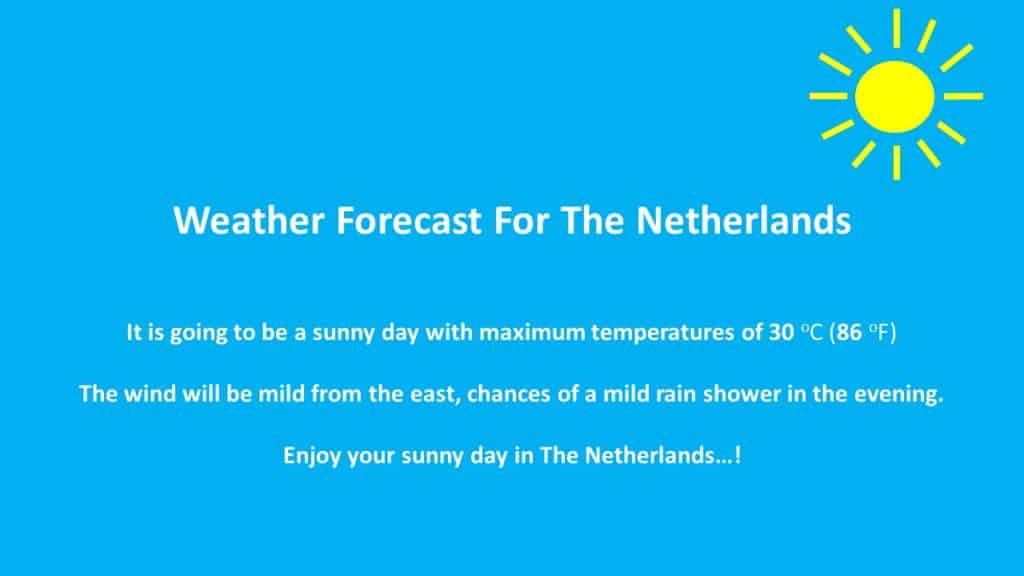
3. How Warm Does It Get In The Netherlands?
The graphs below illustrate the weather in The Netherlands in more detail and are from the Royal Dutch Institute for Meteorology. These graphs are from their yearly review of the weather in 2019.
Maximum temperatures in The Netherlands during summer are ± 30 oC (86 oF ). Maximum temperatures above 35 oC (104 oF) occur only for 1-2 days annually. During winter, temperatures in The Netherlands can still reach maximum temperatures of ± 10 oC (50 oF).
The highest temperature recorded in The Netherlands was 40,7°C (95 oF ) on 25th Juli 2019; such high temperatures are an exception because of the moderate maritime climate. Usually, July is the warmest month of the year In The Netherlands.
The graph of the monthly maximum temperatures in The Netherlands below illustrates the moderate maritime climate in the Netherlands. The North Sea provides a cooling effect in summer and is a moderating influence in winter.
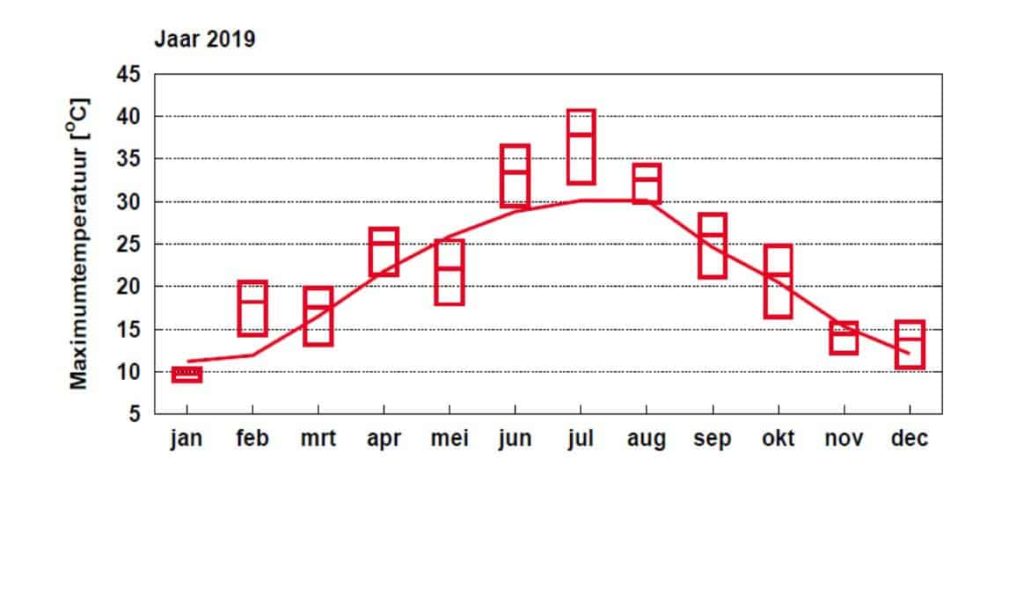
4. How Cold Does It Get In The Netherlands?
Winters in the Netherlands are becoming less severe.
Minimum temperatures may reach -10 oC (14 oF) in The Netherlands during January and February. The lowest temperature ever recorded in The Netherlands was -27.4°C (-17.3 oF) on the 27th of January, 1942.
It seems that winters in the Netherlands are becoming less severe due to climate change. So, unfortunately, the snowy picture of my garden below has become an exception to the rule. However, since we don’t have mountains to enjoy skiing, the lack of snow in The Netherlands is the least of our worries.
Ice skating is a much bigger thing in The Netherlands than skiing. In February 2021, for the first time in almost a decade, we had a period of nearly two weeks in which it froze the entire day. Fortunately, ice skating on the canals of Amsterdam became possible again for the first time in almost a decade.
The Dutch truly celebrate these rare moments of ice-cold weather and skating. Consider yourself lucky to visit the Netherlands in one of these rare winter weeks because you will see an entire country go nuts.


5. Is The Netherlands Cloudy?
It may feel that the Netherlands is always cloudy, but it is much sunnier than it feels. The Netherlands is cloudy during autumn and winter but surprisingly sunny during spring and summer.
The Netherlands has ± 50 days annually without sun, primarily during November-January. On the other 315 days with sun, daily hours of sunshine vary between 1-2 hours during November-January and 5-7 hours/day during April-September.
Of note, the coastal areas of The Netherlands are 10-20% sunnier than the interior. Therefore, you will get a completely different impression of the Dutch weather if you visit The Netherlands in summertime near than coast than in wintertime in the east.
It may look like it is always cloudy, but it is not that bad. For example, the graph below shows that the sun shines, on average, 5-7 hours/day from April until September.
6. How Many Sunny Days In The Netherlands?
During some months in the Netherlands, the weather is much better than in others. For example, if you visit The Netherlands somewhere between October and January, you will not see the sun often and conclude that life in The Netherlands consists of grey clouds only.
The Netherlands has had 45-54 days annually without sun (2019-2021). Most days without any sun in The Netherlands are from November-January. You will not see any sunshine in The Netherlands during about half of the November-January days. This period gained The Netherlands its reputation as a grey and cold country.
However, ± 50 days without sunshine in The Netherlands implies sunshine on the other 315 days of the year. So, how much sun is there with any sunshine on these 315 days annually?
The sun shines on average 1-2 hours/day during autumn and winter in The Netherlands but 5-7 hours/day during spring and summer.

7. What Is The Sunniest Region In The Netherlands?
The hours of sunshine you will get in The Netherlands depend primarily on your location in The Netherlands.
The coastal areas of The Netherlands with its North Sea beaches are the sunniest areas of the country. Zeeland is the sunniest region in The Netherlands.
The drawback is that these coastal areas also receive the most rain. However, if you spend a few weeks of vacation in The Netherlands, you will start to understand why it is such a green country.

If you are looking for much more sun, you may want to visit the tropical Dutch islands, Curaçao, Aruba, or Bonaire, before the coast of Venezuela. You will find much more sun on these islands than in any other place in The Netherlands.

8. Does It Rain A Lot In The Netherlands?
It may feel that it rains a lot in The Netherlands, but that is not the case, although the Dutch like to complain about the weather.
It rains frequently, but not a lot in The Netherlands because the annual rainfall is 780 mm, similar to other European countries. It rains 120-150 days/ year in The Netherlands, spread evenly over the year, and rain showers usually last 1-3 hrs.
It rains 50% more in the western part of the Netherlands than in the east.
Rain showers last shorter during the summer. An occasional shower at the end of a sunny summer day is not uncommon. Check out this article for the 30 best activities in the Netherlands when it rains. Those rain showers don’t last long and won’t bother you if you have a fun indoor activity.
The dryest period of the year is springtime, and spring is the best time to visit The Netherlands. You can also watch the tulip fields in all their glory in springtime. Find the best tulip areas in this post.
If you visit The Netherlands from October until January, prepare for more cloudy and rainy weather.
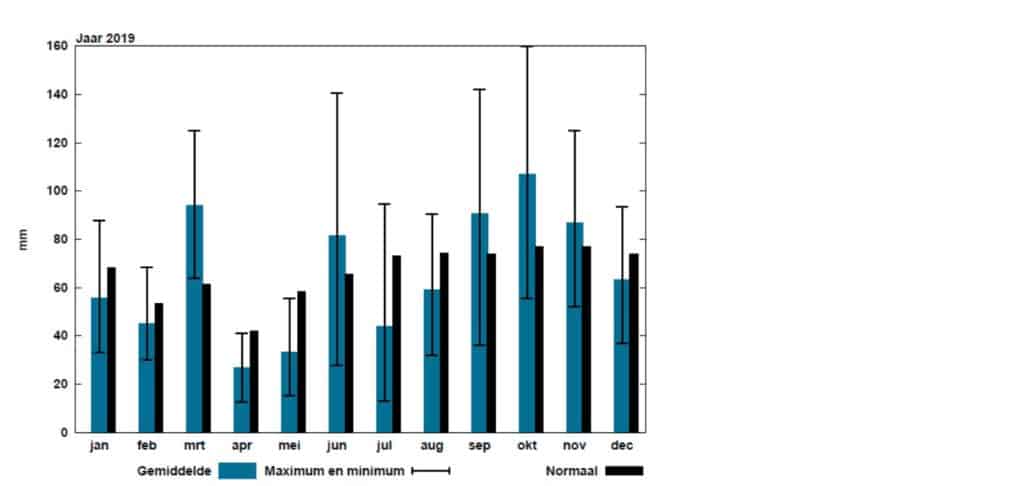
As you can see in the graph above, rainfall is highly variable. However, most of the rain falls in the western part of the country. In the country’s west, it rains twice as much as in the east.
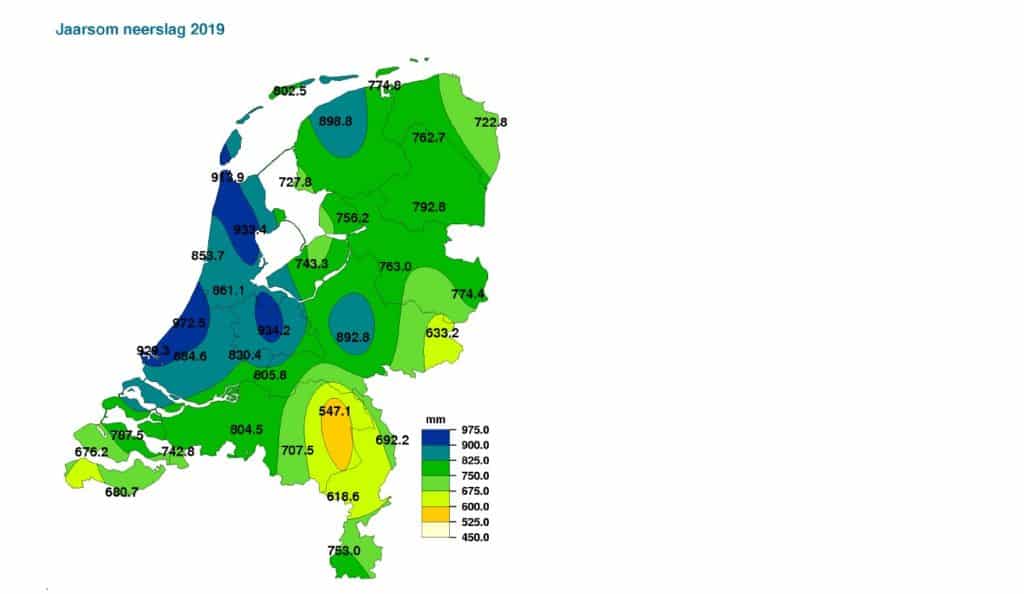
You get more sunshine and rain in the coastal regions. Summer is not notably dryer than other parts of the year. The occasional rain shower can be quite something at the end of a great summer day, with 20 mm of rain in a few hours. The interior is dryer and warmer, but the price to pay for that is less sunshine.
9. How Windy Is The Netherlands?
The wind can play an important role in the weather of the Netherlands and is a hotly debated topic among Dutchmen.
As a whole, there is as much wind in The Netherlands as in other European countries. However, wind speeds in the west of The Netherlands are two times higher than in the east. Furthermore, wind speeds during winter are 20-30% higher than during summer.
Strong winds occur pretty regularly. On ± 27 days a year, the average daily wind in The Netherlands is 50 km/hr or more (7 Bft). Fortunately, storm winds of more than 75 km/hr (9 Bft) occur only eight days/per year. The highest wind speed recorded in The Netherlands was 126 km/hour on the 7th of September, 1944.
What makes the wind in The Netherlands different from other countries is the flatness of the country. The wind remains undisturbed by hills or mountains. That is part of why we have so many windmills in The Netherlands. Unsurprisingly, most windmills are located in the western part of The Netherlands because of the higher wind speeds in that part of the country.
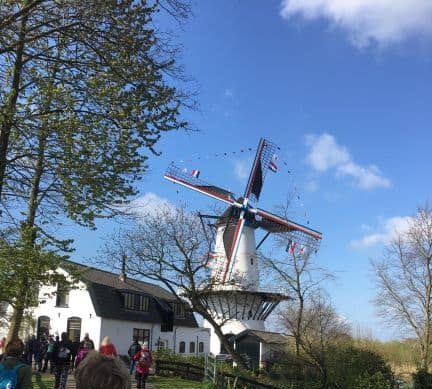

10. The Most Accurate Online Dutch Weather Forecast
If the time of your visit to The Netherlands approaches, it is helpful to check out the weather for that period.
In my experience, the most reliable weather forecast for the Netherlands is Buienradar. You can find their weather forecast for The Netherlands for the next 14 days here.
Buienradar also has an app for mobile phones, and I use this app myself several times a day. I particularly like the live screens with incoming rain and satellite shots with clouds. In addition, the Buienrader app helps me figure out what the weather will be like in the next few hours. That is rather helpful, given the weather variability in The Netherlands.
11. What Clothes Should I bring To The Netherlands?
The chances are that you will have an active vacation and do a lot of walking and biking in and around the cities.
Given the variability of our weather, layering is everything regarding clothes in The Netherlands. It allows you to take off that sweater if it is warm and keep it on if it remains colder than expected.
Bring a rain jacket if you have to survive that occasional shower if you have not been looking at your Buienradar app as much as the Dutch do (a few times per hour) and get surprised by the rain. Of course, the chances are that this will happen once or twice to you, but you will learn fast…!
Jeans are standard, and skinny jeans are very much in fashion at the moment and an excellent choice for a cooler day. Shorts are handy for active vacations and are seen everywhere, from the beaches to the large cities.
And last but not least, bring your umbrella, just in case…!
